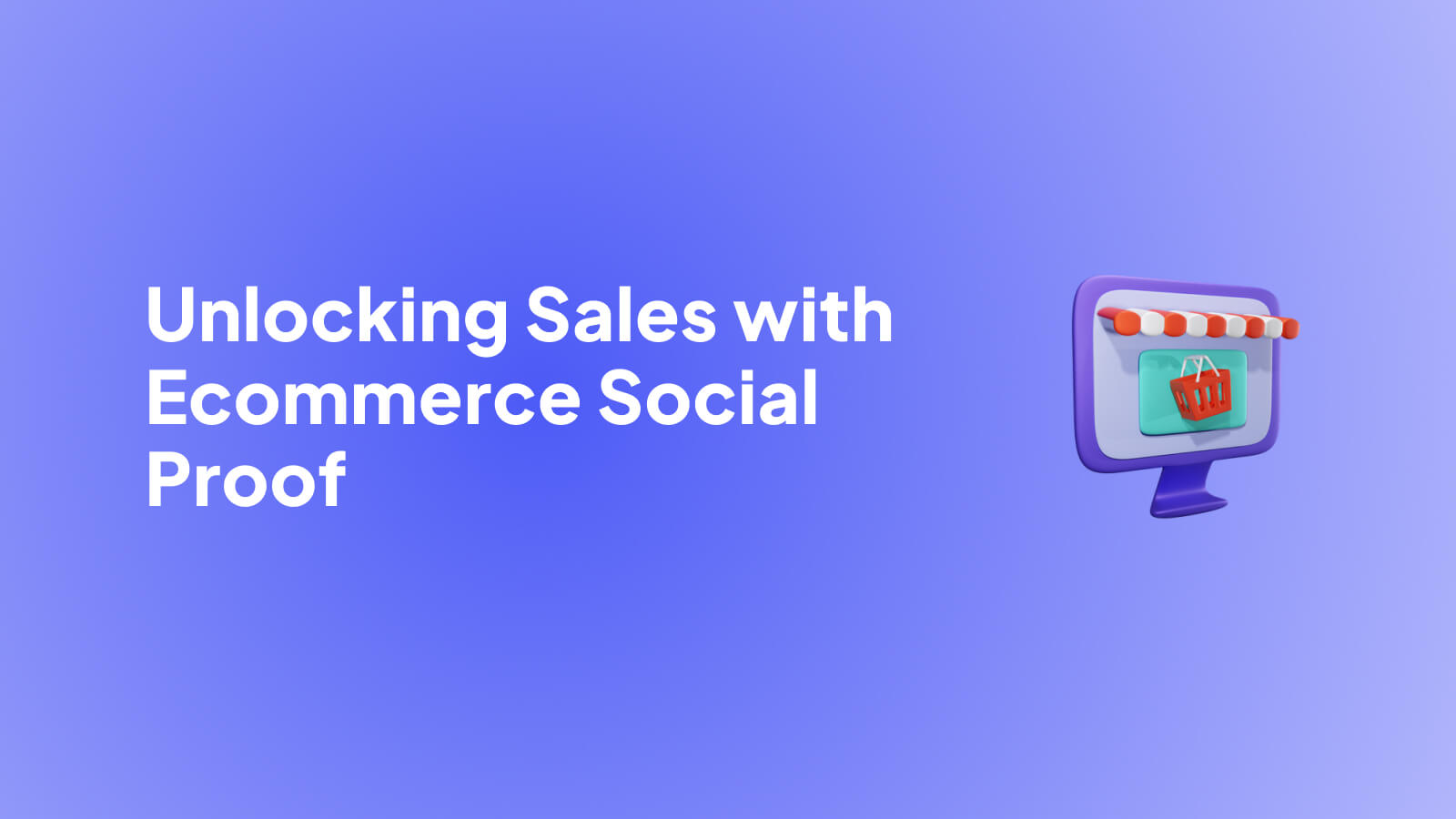
Here's the thing about ecommerce social proof: it's just the digital version of seeing a packed restaurant with a line out the door. You immediately think, "Wow, that place must be good." This powerful psychological shortcut uses the actions of others—their purchases, reviews, and social media shout-outs—to show potential customers that your brand is the real deal.
Building Confidence in a Digital World
Think about the fundamental challenge of online shopping. Customers can't touch, feel, or try out products before they buy. That creates a natural sense of uncertainty and risk with every click. Social proof is what closes that gap, giving shoppers the reassurance they need to pull the trigger.
It all comes down to a basic human instinct called informational social influence. We’re wired to look at what others are doing to figure out the right way to act, especially when we're unsure. When a visitor sees that hundreds of people have already bought and loved a product, it sends a clear signal: this is a safe, smart purchase.
Why Social Proof Isn't Just a "Nice-to-Have"
In today's crowded market, social proof isn't an optional extra; it's a vital engine for growth. A brand without it is like that empty restaurant on a Saturday night. No matter how incredible your food—or your products—might be, people are going to walk right on by. You have to build that foundation of trust first.
By showing that real people are already buying from and loving your brand, you’re not just selling a product. You’re offering security, community, and belonging, which goes a long way in calming a shopper's natural skepticism.
The numbers don't lie. Online reviews have become the bedrock of consumer trust. One study found that a staggering 88% of consumers now trust them just as much as a recommendation from a friend. This trust has a direct impact on the bottom line, with some sites seeing conversion rates jump by as much as 67% after adding customer reviews. You can dive deeper into these kinds of stats in this report on social proof statistics.
To really understand how this works, let's break down the psychological triggers and the direct business benefits.
The Impact of Social Proof on Customer Behavior
This table shows the connection between the psychological principles at play and how they directly help your store.

Simply put, these triggers work together to make the buying process feel less like a gamble and more like a smart, validated choice.
At the end of the day, getting social proof right means turning your happiest customers into your most powerful advocates. It’s authentic, it's persuasive, and it's one of the most reliable ways to grow your business.
The Most Powerful Types of Social Proof for Your Store
Not all social proof is created equal. While any form of customer validation is a good thing, certain types pack a much bigger punch when it comes to building trust and actually driving sales. Think of these as the heavy hitters in your marketing toolkit, each one perfectly suited for a different job in guiding a shopper's decision.
The most fundamental type, and one you absolutely can't skip, is the classic customer review. This is the bread and butter of digital trust. It's no surprise that the average customer now reads about 10 online reviews before they feel comfortable enough to pull the trigger on a purchase. These testimonials offer a direct line of sight into product quality, sizing, and the overall customer experience, all from someone who has already taken that leap of faith.
The Rise of Authentic Content
But today, we've moved well beyond simple star ratings. User-Generated Content (UGC) has exploded onto the scene, becoming a true powerhouse for modern brands. This is the real-deal content—photos and videos from actual customers using your products in their day-to-day lives. UGC feels less like a polished ad and more like an honest-to-goodness recommendation from a friend, which makes it incredibly persuasive.
After all, seeing a product on a professional model is one thing. Seeing it on someone who looks just like you, in a setting you recognize? That's far more relatable and powerful. This craving for authenticity is why a staggering 87% of buying decisions now start with online research, where shoppers are actively hunting for this kind of real-world proof.
To help you see how these pieces fit together, here's a quick look at the core types of social proof.
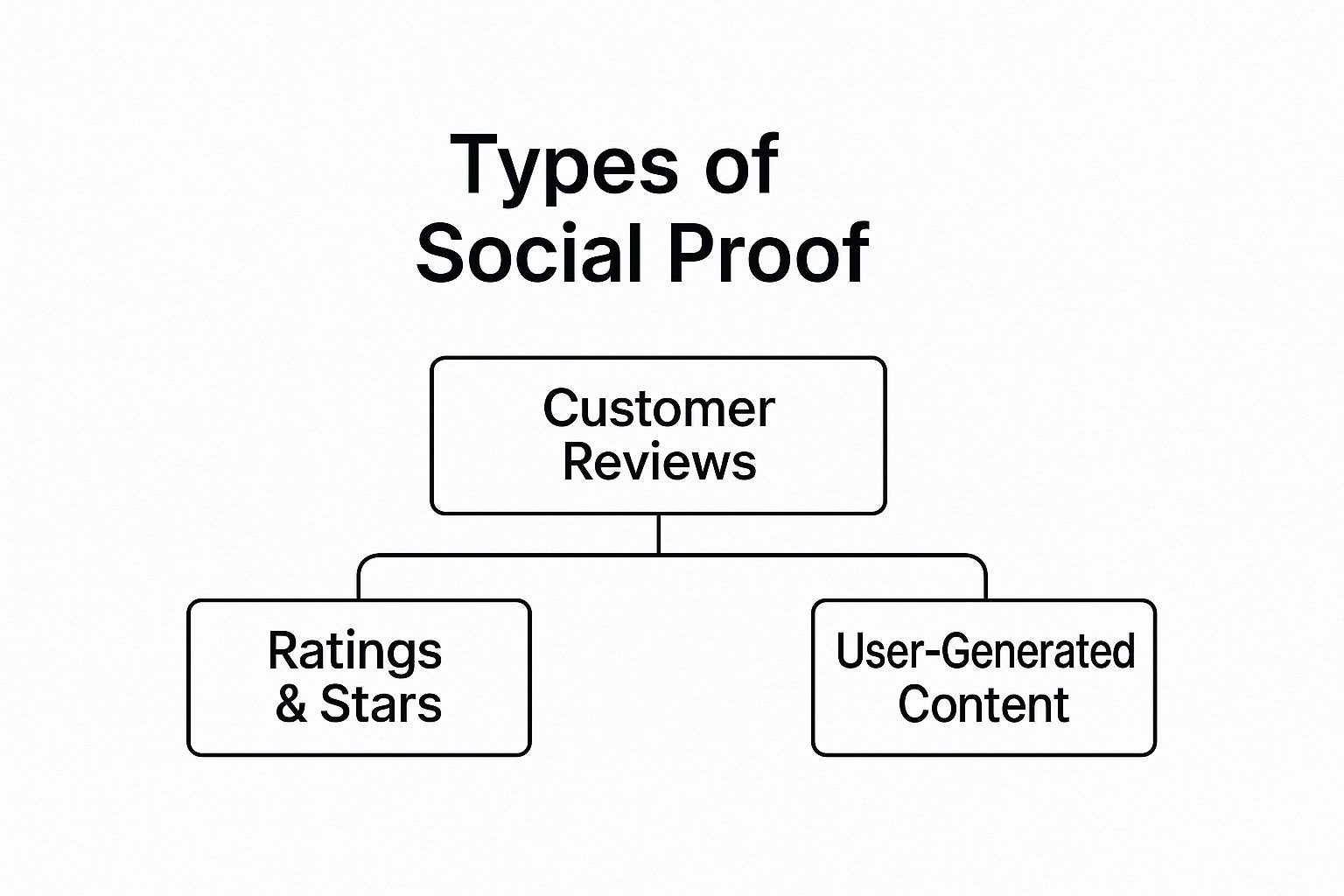
This graphic really drives home how customer reviews, ratings, and user-generated content all act as essential pillars holding up your store's credibility.
Tapping into Influence and Urgency
Beyond reviews and photos, another key category involves tapping into trusted voices and a bit of psychology. This includes:
- Influencer Collaborations: While a big-name celebrity can give you massive reach, partnerships with micro-influencers often deliver much higher engagement. These creators have smaller, highly dedicated audiences who genuinely trust their recommendations.
- Real-Time Notifications: You’ve seen them—those little pop-ups that say, "Someone in Austin just bought this!" They work because they tap directly into our Fear of Missing Out (FOMO). These notifications show your store is busy and your products are in demand, creating a subtle but effective sense of urgency.
- 'Bestseller' Badges: Highlighting your most popular items is a simple but brilliant shortcut for shoppers. It signals that a product is a safe bet, already validated by the choices of countless others, which makes the decision-making process a whole lot easier.
By weaving these different forms of social proof together, you create a rich, layered experience that reassures customers at every single step of their journey. It's about showing, not just telling, that your brand is one people trust and love.
If you're looking for some fantastic real-world examples, you can find tons of inspiration in these https://moast.io/101-examples-of-the-best-e-commerce-social-proof. And to really make your social proof shine, it helps to have an engaged community creating it. You can learn more with these 10 Proven Ways to Boost Social Media Engagement. Marrying strong on-site proof with a buzzing social presence is how you build a brand that customers are excited to champion.
Turning Customers Into Your Best Marketers
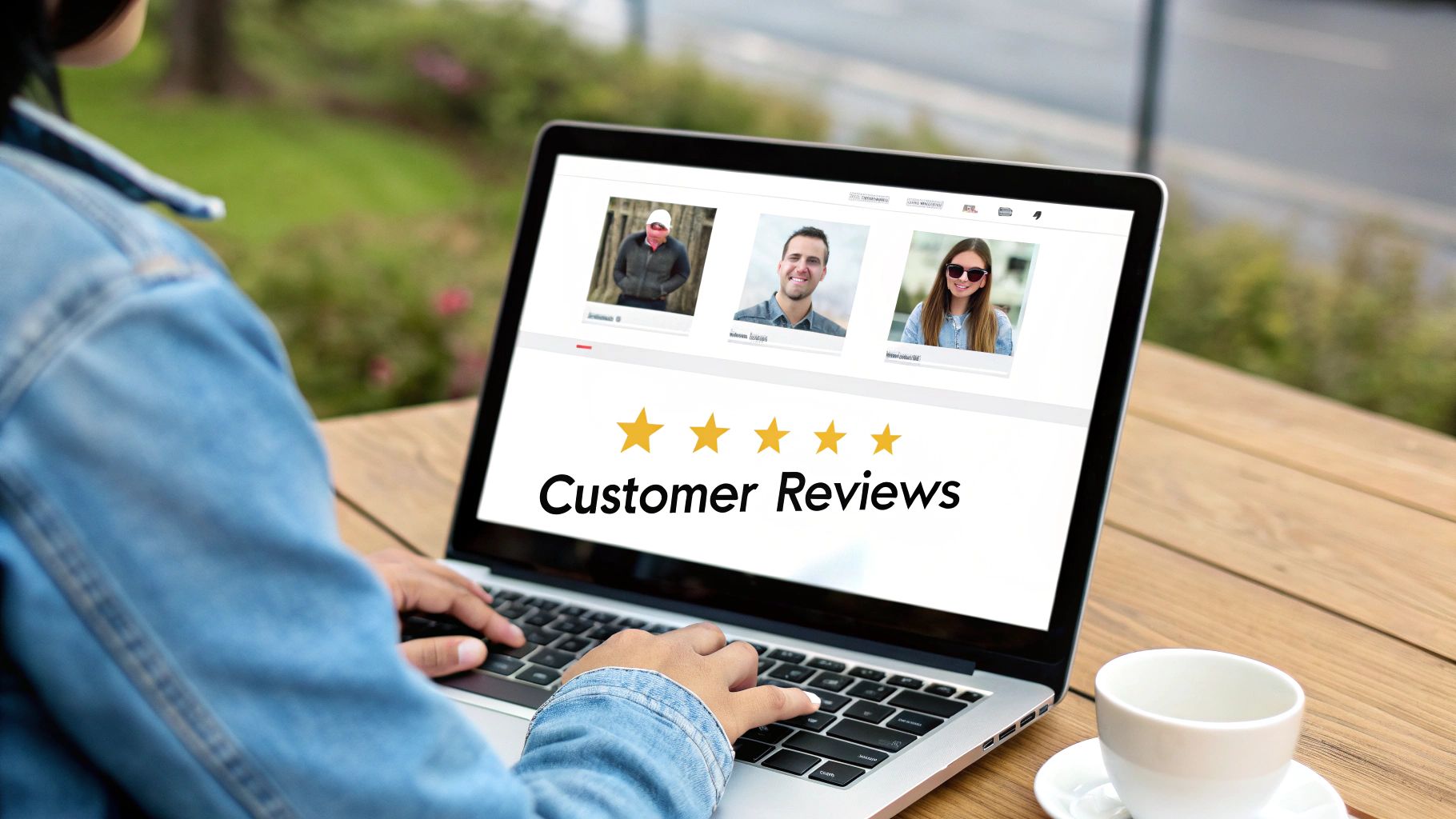
Real, powerful social proof doesn't just happen by magic. The smartest brands know this and don't just sit back waiting for it. They build a system that encourages happy customers to become their most passionate advocates. This is the key difference between stores that get a few random reviews and those that are flooded with compelling, sales-driving content.
The whole process kicks off the second a customer hits "buy." This is your golden window to start a conversation and create a feedback loop that feels genuinely helpful, not just another marketing ask. The trick is to make leaving a review or sharing a photo ridiculously easy.
Crafting the Perfect Post-Purchase Flow
Your post-purchase email sequence is your secret weapon for gathering reviews and user-generated content (UGC). But timing is critical. If you ask for a review before the product has even shown up, you’re just creating annoyance. You have to be strategic.
A good rule of thumb is to send your first request about 7-14 days after delivery. This gives your customer enough time to actually use the product and form an opinion. Keep this first email short and sweet—a simple, friendly check-in asking for a star rating or a quick comment is perfect. For a masterclass on this and other clever tactics, see how these 10 brands boosting sales with social proof do it.
Remember, the goal isn’t to hound your customers. It's to connect with them right when their excitement for the product is highest. A well-timed, easy-to-answer request can make all the difference.
Follow up a week or so later with a second email. This time, you can specifically ask for a photo or video. This is a great time to offer a small thank you, like a 10% discount on their next order or an entry into a giveaway. Suddenly, it’s not a chore; it’s a win-win.
Inspiring User-Generated Content
Emails are just one piece of the puzzle. You can also spark UGC creation with dedicated campaigns. A social media contest using a branded hashtag is a classic for a reason—it works. Ask customers to post photos showing off how they use your products for a chance to win something or get featured on your feed. This generates a ton of great content while also building a genuine community around your brand.
Here are a few more practical ideas to get the UGC flowing:
- Create "Instagrammable" Packaging: Make the unboxing experience so visually satisfying that people can't help but share it.
- Run Themed Contests: Center campaigns around a season, holiday, or a creative way to use your product.
- Showcase Your Customers: When someone tags you in an awesome post, do more than just like it. Ask for their permission to feature it on your product pages, in your ads, and on your main social accounts. This kind of recognition is a huge motivator.
When you actively collect and feature this kind of content, you're doing more than just gathering ecommerce social proof. You're building a rich, authentic story about your brand, told by the people who matter most. That real-world narrative is one of the most powerful marketing tools you’ll ever have.
How to Build Instant Trust with Badges and Signals
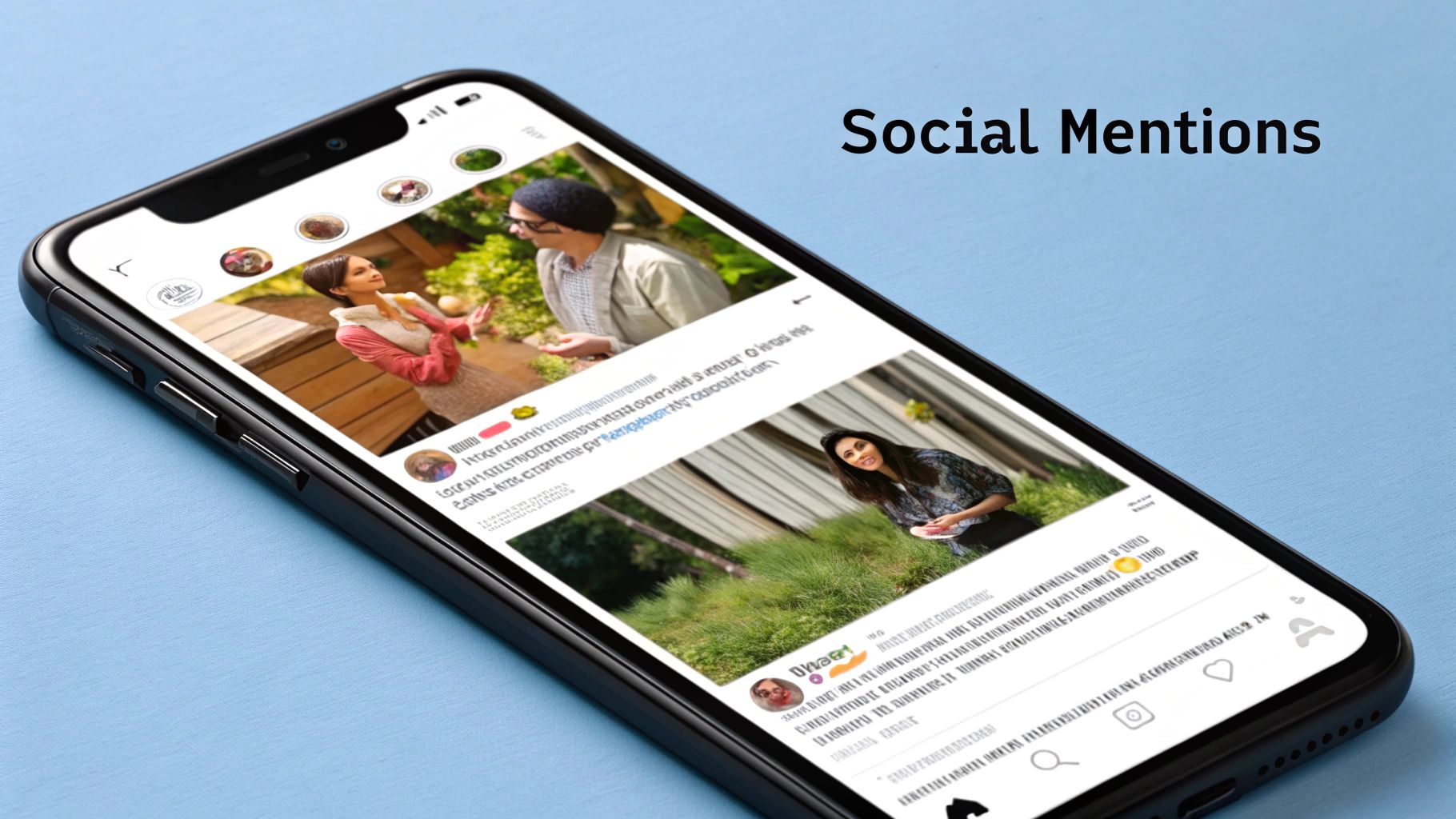
When a shopper lands on your site, the clock starts ticking. You have just a few seconds to win them over and earn their trust. This is where subtle visual cues—the kind that are easy to overlook—can do some serious heavy lifting. These badges and signals are your silent salespeople, telling shoppers your store is legit, secure, and a popular place to buy.
Think of them as a firm digital handshake. Seeing a familiar logo like PayPal, Visa, or a security seal from a trusted name like McAfee instantly eases a customer’s worries about their personal data. This is absolutely critical on your checkout pages. After all, 18% of shoppers ditch their carts simply because they don't trust a site with their credit card info. A few well-placed badges are a simple, effective way to show you take their security seriously.
The same principle of using visual cues for credibility applies in the physical world, too. Just as a trust badge works online, there are many effective small business signs that serve as a powerful first impression for brick-and-mortar shops.
Harnessing the Wisdom of the Crowd
Security is one thing, but what about popularity? Another incredibly powerful form of social proof comes from what we call "wisdom of the crowd" indicators. These are the little badges that signal quality and demand, tapping directly into our basic human instinct to follow the herd.
When we see a product flagged as a “Bestseller” or “Top-Rated,” our brain gets a shortcut. It tells us, "Hey, lots of other people bought this and liked it, so it's probably a safe bet." These small icons have an outsized impact on buying decisions. In fact, 28% of online shoppers say visual cues like a 'bestseller' icon are 'very' or 'extremely' important to them. The proof is in the numbers—products that earn an 'Amazon’s Choice' badge can see their conversion rates jump by 25%.
Strategically Placing Your Trust Signals
To really make these signals count, you can’t just throw them everywhere. You need a smart placement strategy, carefully layering these trust-builders throughout the customer’s entire journey on your site.
- Homepage: Got press? Feature “As Seen In” logos from well-known publications right away to establish authority the moment someone arrives.
- Product Pages: Use badges like “Bestseller” or “Staff Pick” on specific items. This helps guide shoppers who might be on the fence.
- Checkout: This is the big one. Make sure your security seals and accepted payment logos are displayed clearly and prominently. It’s non-negotiable.
By thoughtfully integrating these visual trust signals, you create a seamless environment of security and credibility. You’re effectively answering a shopper’s biggest unspoken questions before they even have to ask them.
Learning how to weave these elements into your site's design is a game-changing skill for any store owner. For a deeper dive, check out our guide on the essential ways to embed social proof in your ecommerce site.
Your Blueprint for Implementing Social Proof
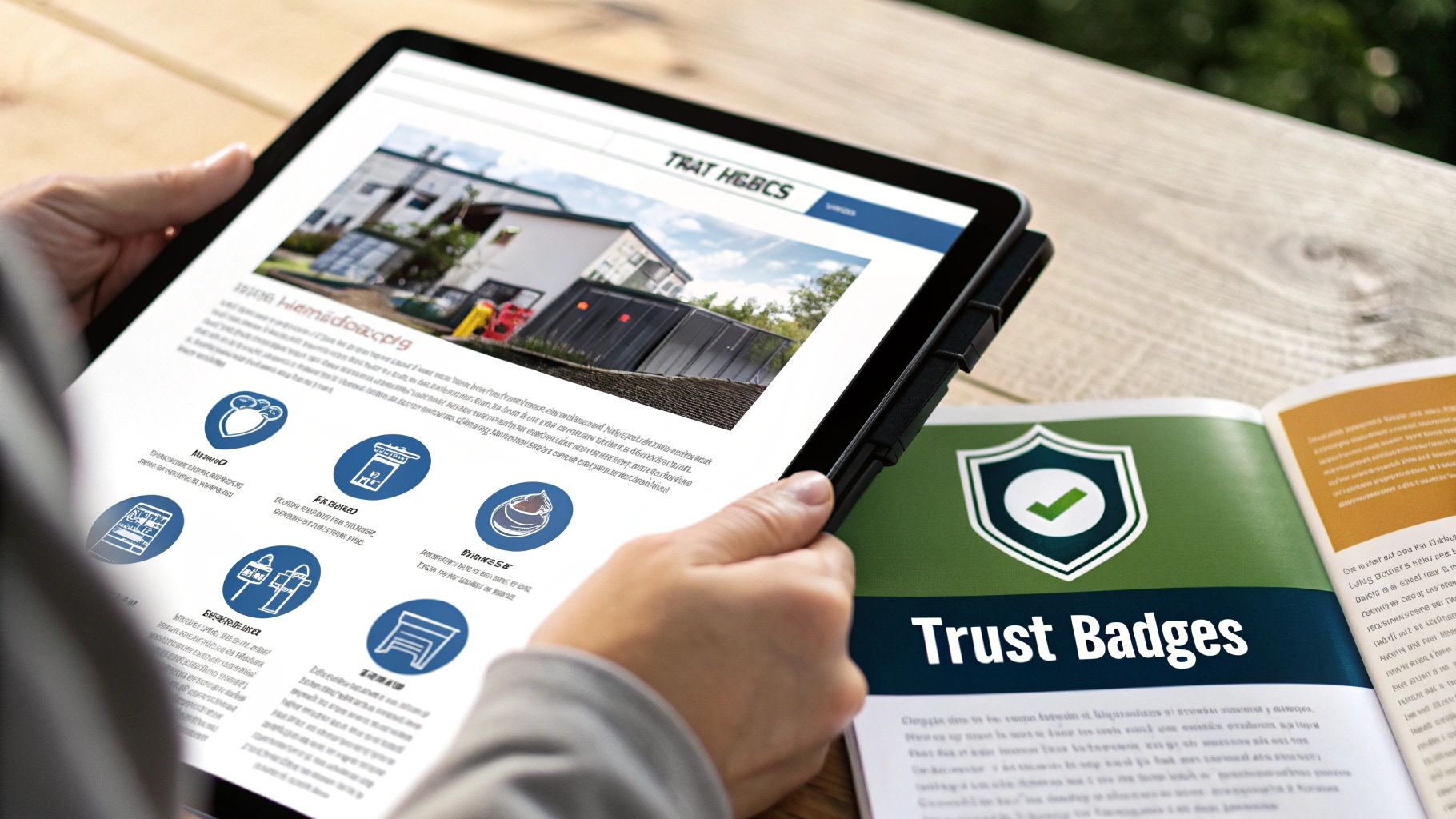
Knowing what social proof is and actually putting it to work are two different things. This is where the magic happens. A smart strategy isn't about just slapping reviews on your site and calling it a day. It’s about weaving the right kind of proof into the right moments of the customer journey, building trust without making your pages feel cluttered or overwhelming.
Think of your homepage as your digital storefront. It’s your first chance to make a good impression and establish credibility. This is the perfect place for your most powerful, at-a-glance social proof. Consider a carousel showing off your best five-star reviews or a row of "As Seen In" logos from press you’ve earned. Right away, you're telling new visitors that your brand is legitimate and that others already trust you.
Once you’ve made that initial connection, the real work begins on your product pages. This is where customers wrestle with the decision to buy, so you need to deploy different kinds of proof to answer their unasked questions and calm their hesitations.
Strategic Placements on Your Product Pages
Your product pages need to be a goldmine of genuine validation. Star ratings are a must-have, but you have to go deeper if you want to win over a truly skeptical shopper. One of the most effective tools in your arsenal is a dynamic gallery of user-generated content (UGC) showing real people using your product. Nothing makes a product feel more real and relatable than seeing it out in the wild.
Here's how to think about placing proof on your product pages:
- Above the Fold: The star rating and total review count should be impossible to miss, sitting right next to the product title.
- Below the Description: This is the spot for a full review widget, letting shoppers dive into detailed feedback and browse customer photos.
- Near the 'Add to Cart' Button: A small, dynamic notification like "25 people bought this today" can add a subtle nudge of urgency.
The goal is to build a convincing story. A shopper sees the high star rating, scrolls down to read a glowing review from a verified buyer, and then sees a photo of someone just like them happily using the product. Each piece of evidence supports the last, making the decision to buy feel like a safe, smart move.
Securing the Final Step at Checkout
Don't forget about the checkout process! This is the final hurdle, where last-minute doubts can easily lead to an abandoned cart. You can fight this by reinforcing trust with simple, clear visuals.
Make sure to prominently display security seals from services like McAfee or Norton, right alongside the familiar logos of payment options like Visa and PayPal. These symbols are a powerful, unspoken promise that the customer’s financial details are secure.
For store owners looking to make all of this happen, there are fantastic tools that can automate much of the work. Apps like Yotpo, Loox, and Stamped.io are brilliant for collecting reviews and displaying UGC. For those real-time purchase notifications, services like ProveSource or Fomo integrate smoothly with platforms like Shopify.
These tools make implementing powerful ecommerce social proof a reality for any business, helping you build a store that not only looks great but also feels trustworthy.
Common Questions About Ecommerce Social Proof
Even with the best strategy, putting social proof into action can bring up some tricky questions. Let's walk through a few of the most common challenges that pop up, so you can handle them with confidence and sidestep any potential bumps in the road.
One of the first hurdles new stores face is the classic "chicken-and-egg" problem. How are you supposed to get reviews when you don't have any customers? It all comes down to being proactive right from your very first sale.
How Do I Get Reviews When My Store Is New?
Start by personally reaching out to your first handful of customers. Don't send a generic, automated blast—write a thoughtful email that feels like a genuine check-in from a real person.
As a thank you for their feedback, you could offer a small discount on a future purchase. Frame it not as a bribe, but as a sincere reward for being an early supporter of your brand.
Another great move is to send your products to a few micro-influencers who are genuinely active in your niche. Their honest feedback can give you that initial spark of credibility you need. The goal is to make leaving a review feel simple, rewarding, and part of a special experience.
Never, ever delete negative reviews (unless they're obvious spam, of course). Responding to them publicly and professionally shows you're accountable. A negative review handled with grace can actually build more trust than a page full of flawless five-star ratings.
This kind of transparency shows you’re a real business that listens to its customers, which is the cornerstone of building brand trust through user-generated content.
Does Social Proof Work for High-Ticket Products?
Absolutely. You could even argue it’s more critical for expensive items, where the customer feels like they're taking a much bigger risk. When the price tag is high, simple star ratings just won't cut it. You have to go deeper.
For these kinds of products, concentrate on gathering more substantial proof:
- In-depth testimonials that tell a story—from the customer's initial problem to how your product solved it.
- Detailed case studies that combine a compelling narrative with hard data, proving the ROI and value.
- Video reviews where customers can authentically share their excitement and show the product in action.
Expert endorsements from respected figures in your industry also carry enormous weight. For a major purchase, this kind of validation can be the one thing that convinces a hesitant shopper to finally click "buy." You're not just selling a product; you're building an undeniable case for its quality and value.
Ready to turn your best customer content into your most powerful sales tool? Moast allows Shopify merchants to add free shoppable videos to their store in minutes. Showcase your best content, Reels, and TikToks right on your product pages—with unlimited views, no limits, and 100% free. Start converting with Moast today.
Related content
Turn your videos into sales
Boost conversions by up to 30% by turning your existing TikToks and Reels into shoppable videos directly on your Shopify store.




.jpg)







